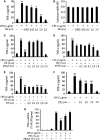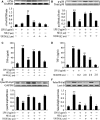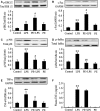α₁ adrenoceptor activation by norepinephrine inhibits LPS-induced cardiomyocyte TNF-α production via modulating ERK1/2 and NF-κB pathway
- PMID: 24304472
- PMCID: PMC3930413
- DOI: 10.1111/jcmm.12184
α₁ adrenoceptor activation by norepinephrine inhibits LPS-induced cardiomyocyte TNF-α production via modulating ERK1/2 and NF-κB pathway
Abstract
Cardiomyocyte tumour necrosis factor α (TNF-α) production contributes to myocardial depression during sepsis. This study was designed to observe the effect of norepinephrine (NE) on lipopolysaccharide (LPS)-induced cardiomyocyte TNF-α expression and to further investigate the underlying mechanisms in neonatal rat cardiomyocytes and endotoxaemic mice. In cultured neonatal rat cardiomyocytes, NE inhibited LPS-induced TNF-α production in a dose-dependent manner. α₁- adrenoceptor (AR) antagonist (prazosin), but neither β₁- nor β₂-AR antagonist, abrogated the inhibitory effect of NE on LPS-stimulated TNF-α production. Furthermore, phenylephrine (PE), an α₁-AR agonist, also suppressed LPS-induced TNF-α production. NE inhibited p38 phosphorylation and NF-κB activation, but enhanced extracellular signal-regulated kinase 1/2 (ERK1/2) phosphorylation and c-Fos expression in LPS-treated cardiomyocytes, all of which were reversed by prazosin pre-treatment. To determine whether ERK1/2 regulates c-Fos expression, p38 phosphorylation, NF-κB activation and TNF-α production, cardiomyocytes were also treated with U0126, a selective ERK1/2 inhibitor. Treatment with U0126 reversed the effects of NE on c-Fos expression, p38 mitogen-activated protein kinase (MAPK) phosphorylation and TNF-α production, but not NF-κB activation in LPS-challenged cardiomyocytes. In addition, pre-treatment with SB202190, a p38 MAPK inhibitor, partly inhibited LPS-induced TNF-α production in cardiomyocytes. In endotoxaemic mice, PE promoted myocardial ERK1/2 phosphorylation and c-Fos expression, inhibited p38 phosphorylation and IκBα degradation, reduced myocardial TNF-α production and prevented LPS-provoked cardiac dysfunction. Altogether, these findings indicate that activation of α₁-AR by NE suppresses LPS-induced cardiomyocyte TNF-α expression and improves cardiac dysfunction during endotoxaemia via promoting myocardial ERK phosphorylation and suppressing NF-κB activation.
Keywords: Lipopolysaccharide; Tumour necrosis factor-α; cardiomyocytes; α1-adrenoceptor.
© 2013 The Authors. Journal of Cellular and Molecular Medicine published by John Wiley & Sons Ltd and Foundation for Cellular and Molecular Medicine.
Figures






Similar articles
-
JNK1/c-fos inhibits cardiomyocyte TNF-alpha expression via a negative crosstalk with ERK and p38 MAPK in endotoxaemia.Cardiovasc Res. 2009 Mar 1;81(4):733-41. doi: 10.1093/cvr/cvn336. Epub 2008 Nov 29. Cardiovasc Res. 2009. PMID: 19043087
-
Alpha-1 Adrenergic Receptor Agonist Phenylephrine Inhibits Sepsis-Induced Cardiomyocyte Apoptosis and Cardiac Dysfunction via Activating ERK1/2 Signal Pathway.Shock. 2019 Jul;52(1):122-133. doi: 10.1097/SHK.0000000000001205. Shock. 2019. PMID: 29889817
-
β₁-adrenoceptor stimulation promotes LPS-induced cardiomyocyte apoptosis through activating PKA and enhancing CaMKII and IκBα phosphorylation.Crit Care. 2015 Mar 9;19(1):76. doi: 10.1186/s13054-015-0820-1. Crit Care. 2015. PMID: 25887954 Free PMC article.
-
Tumor necrosis factor in the heart.Am J Physiol. 1998 Mar;274(3):R577-95. doi: 10.1152/ajpregu.1998.274.3.R577. Am J Physiol. 1998. PMID: 9530222 Review.
-
Overview of pyroptosis mechanism and in-depth analysis of cardiomyocyte pyroptosis mediated by NF-κB pathway in heart failure.Biomed Pharmacother. 2024 Oct;179:117367. doi: 10.1016/j.biopha.2024.117367. Epub 2024 Aug 29. Biomed Pharmacother. 2024. PMID: 39214011 Review.
Cited by
-
Intrinsic cardiac adrenergic cells contribute to LPS-induced myocardial dysfunction.Commun Biol. 2022 Jan 25;5(1):96. doi: 10.1038/s42003-022-03007-6. Commun Biol. 2022. PMID: 35079095 Free PMC article.
-
The alpha-1A adrenergic receptor agonist A61603 reduces cardiac polyunsaturated fatty acid and endocannabinoid metabolites associated with inflammation in vivo.Metabolomics. 2016 Oct;12(10):155. doi: 10.1007/s11306-016-1097-3. Epub 2016 Sep 15. Metabolomics. 2016. PMID: 28533737 Free PMC article.
-
Norepinephrine ameliorates sepsis-associated acute kidney injury through inhibiting damage of renal tubular epithelium induced by macrophage inflammatory response.BMC Nephrol. 2025 Aug 29;26(1):498. doi: 10.1186/s12882-025-04421-8. BMC Nephrol. 2025. PMID: 40883684 Free PMC article.
-
Beta-adrenoceptor Activation by Norepinephrine Enhances Lipopolysaccharide-induced Matrix Metalloproteinase-9 Expression Through the ERK/JNK-c-Fos Pathway in Human THP-1 Cells.J Atheroscler Thromb. 2017 Jan 1;24(1):55-67. doi: 10.5551/jat.35204. Epub 2016 May 25. J Atheroscler Thromb. 2017. PMID: 27237101 Free PMC article.
-
α1-adrenoceptor stimulation ameliorates lipopolysaccharide-induced lung injury by inhibiting alveolar macrophage inflammatory responses through NF-κB and ERK1/2 pathway in ARDS.Front Immunol. 2023 Jan 6;13:1090773. doi: 10.3389/fimmu.2022.1090773. eCollection 2022. Front Immunol. 2023. PMID: 36685596 Free PMC article.
References
-
- Fernandes CJ, Jr, de Assuncao MS. Myocardial dysfunction in sepsis: a large, unsolved puzzle. Crit Care Res Pract. 2012;2012:896430. Doi: 10.1155/2012/896430. - DOI - PMC - PubMed
-
- Zhang T, Feng Q. Nitric oxide and calcium signaling regulate myocardial tumor necrosis factor-α expression and cardiac function in sepsis. Can J Physiol Pharmacol. 2010;88:92–104. - PubMed
-
- Cain BS, Meldrum DR, Dinarello CA, et al. Tumor necrosis factor-alpha and interleukin-1beta synergistically depress human myocardial function. Crit Care Med. 1999;27:1309–18. - PubMed
-
- Vincent JL, Bakker J, Marécaux G, et al. Administration of anti-TNF antibody improves left ventricular function in septic shock patients. Results of a pilot study. Chest. 1992;101:810–5. - PubMed
Publication types
MeSH terms
Substances
LinkOut - more resources
Full Text Sources
Other Literature Sources
Research Materials
Miscellaneous

